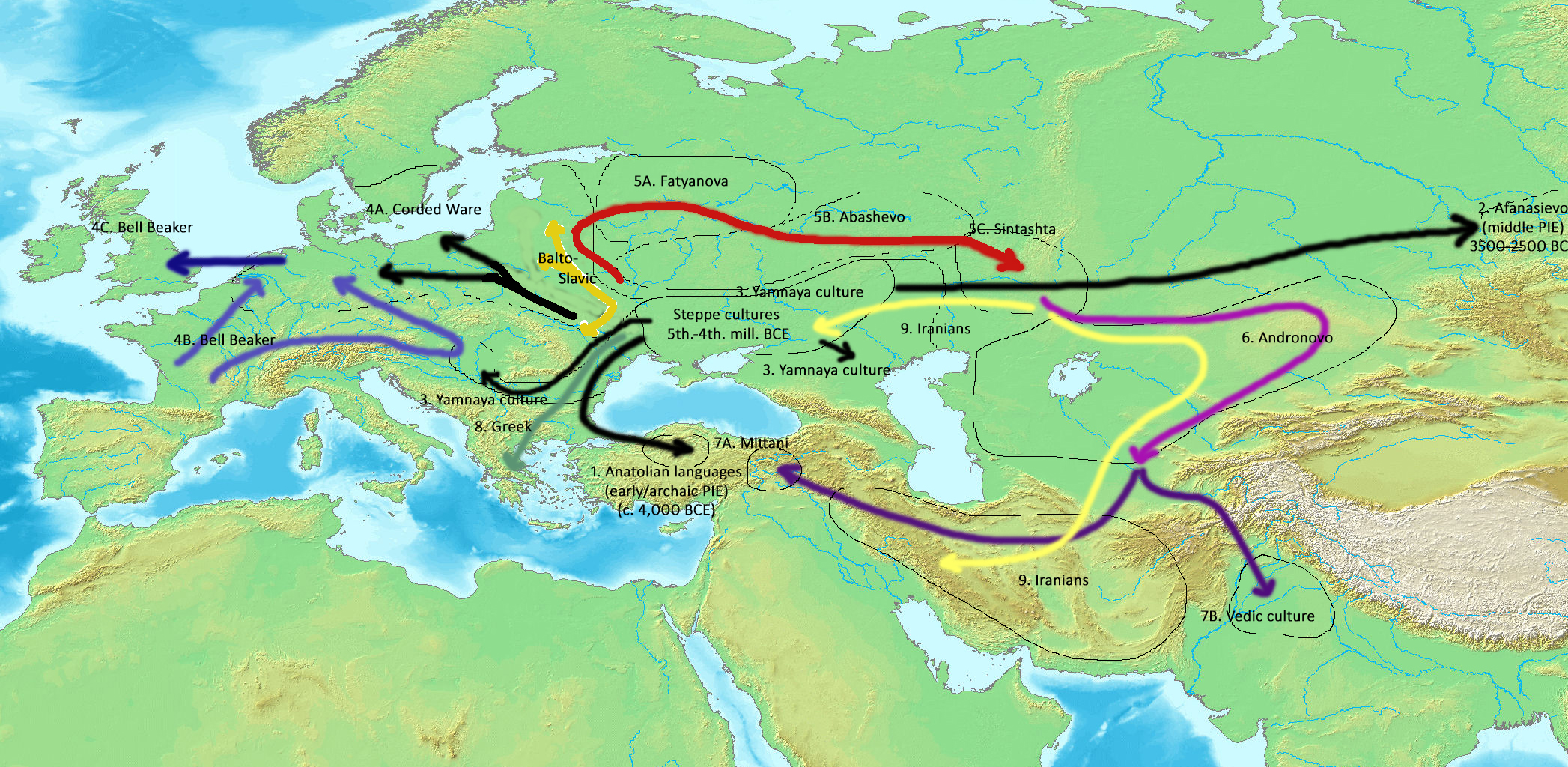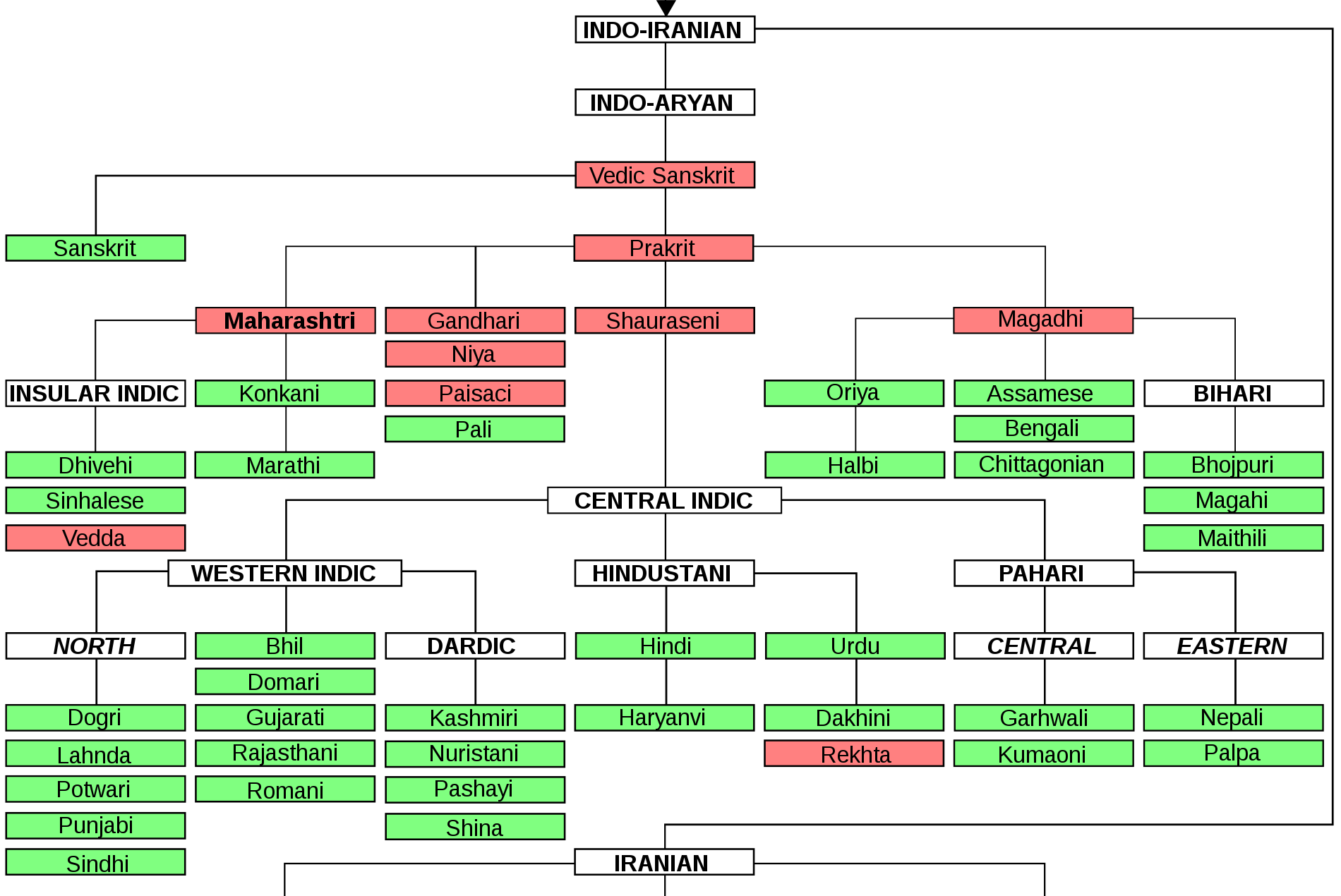|
Indo-Hittite
In Indo-European linguistics, the term Indo-Hittite (also Indo-Anatolian) refers to Edgar Howard Sturtevant's 1926 hypothesis that the Anatolian languages split off a Pre-Proto-Indo-European language considerably earlier than the separation of the remaining Indo-European languages. The prefix ''Indo-'' does not refer to the Indo-Aryan branch in particular, but stands for ''Indo-European'', and the ''-Hittite'' part refers to the Anatolian language family as a whole. Proponents of the Indo-Hittite hypothesis claim the separation preceded the spread of the remaining branches by several millennia, possibly as early as 7000 BC. In this context, the proto-language before the split of Anatolian would be called ''Proto-Indo-Hittite'', and the proto-language of the remaining branches, before the next split, presumably of Tocharian, would be called ''Proto-Indo-European'' (PIE). This is a matter of terminology, though, as the hypothesis does not dispute the ultimate genetic relation ... [...More Info...] [...Related Items...] OR: [Wikipedia] [Google] [Baidu] |
Indo-European Language Histories
The Indo-European languages are a language family native to the northern Indian subcontinent, most of Europe, and the Iranian plateau with additional native branches found in regions such as Sri Lanka, the Maldives, parts of Central Asia (e.g., Tajikistan and Afghanistan), Armenia, and areas of southern India. Historically, Indo-European languages were also spoken in Anatolia. Some European languages of this family—English language, English, French language, French, Portuguese language, Portuguese, Russian language, Russian, Spanish language, Spanish, and Dutch language, Dutch—have expanded through colonialism in the modern period and are now spoken across several continents. The Indo-European family is divided into several branches or sub-families, including Albanian language, Albanian, Armenian language, Armenian, Balto-Slavic, Celtic languages, Celtic, Germanic languages, Germanic, Hellenic languages, Hellenic, Indo-Iranian languages, Indo-Iranian, and Italic languages, ... [...More Info...] [...Related Items...] OR: [Wikipedia] [Google] [Baidu] |
Edgar Howard Sturtevant
Edgar Howard Sturtevant (March 7, 1875 – July 1, 1952) was an American linguist. Biography Sturtevant was born in Jacksonville, Illinois, the older brother of Alfred Sturtevant and grandson of educator Julian Monson Sturtevant. He studied at Illinois College, where his grandfather was president, and obtained an A.B. from Indiana University Bloomington, then the University of Chicago receiving there in 1901 a Ph.D. with a dissertation on Latin case forms. He became an assistant professor of classical philology at Columbia University before joining the linguistics faculty at Yale University in 1923. In 1924, he was a member of the organizing committee for the founding, with Leonard Bloomfield and George M. Bolling, of the Linguistic Society of America (LSA). Besides research on Native American languages and field work on the Modern American English dialects, he is the father of the Indo-Hittite hypothesis, first formulated in 1926, based on his seminal work establishing the ... [...More Info...] [...Related Items...] OR: [Wikipedia] [Google] [Baidu] |
Hittite Language
Hittite (, or ), also known as Nesite (Nešite/Neshite, Nessite), is an extinct Indo-European language that was spoken by the Hittites, a people of Bronze Age Anatolia who created an empire centred on Hattusa, as well as parts of the northern Levant and Upper Mesopotamia. The language, now long extinct, is attested in cuneiform, in records dating from the 17th ( Anitta text) to the 13th centuries BC, with isolated Hittite loanwords and numerous personal names appearing in an Old Assyrian context from as early as the 20th century BC, making it the earliest attested use of the Indo-European languages. By the Late Bronze Age, Hittite had started losing ground to its close relative Luwian. It appears that Luwian was the most widely spoken language in the Hittite capital of Hattusa during the 13th century BC. After the collapse of the Hittite New Kingdom during the more general Late Bronze Age collapse, Luwian emerged in the early Iron Age as the main language ... [...More Info...] [...Related Items...] OR: [Wikipedia] [Google] [Baidu] |
Anatolian Hypothesis
The Anatolian hypothesis, also known as the Anatolian theory or the sedentary farmer theory, first developed by British archaeologist Colin Renfrew in 1987, proposes that the dispersal of Proto-Indo-Europeans originated in Neolithic Anatolia. It is the main competitor to the Kurgan hypothesis, or steppe theory, which enjoys more academic favor. Description The Anatolian hypothesis suggests that the speakers of Proto-Indo-European (PIE) lived in Anatolia during the Neolithic era. It associates the distribution of historical Indo-European languages with the expansion during the Neolithic Revolution of the 7th and the 6th millennia BC. The hypothesis states that Indo-European languages began to spread peacefully, by demic diffusion, into Europe from Asia Minor from around 7000 BC with the Neolithic advance of farming (''wave of advance''). Accordingly, most inhabitants of Neolithic Europe would have spoken Indo-European languages, and later migrations would have replaced the Indo ... [...More Info...] [...Related Items...] OR: [Wikipedia] [Google] [Baidu] |
Laryngeal Theory
The laryngeal theory is a theory in historical linguistics positing that the Proto-Indo-European (PIE) language included a number of laryngeal consonants that are not linguistic reconstruction, reconstructable by direct application of the comparative method (linguistics), comparative method to the Indo-European family. The "missing" sounds remain consonants of an indeterminate place of articulation towards the back of the mouth, though further information is difficult to derive. Proponents aim to use the theory to: * Produce greater regularity in the reconstruction of PIE phonology than from the reconstruction that is produced by the comparative method. * Extend the general occurrence of the Indo-European ablaut to syllables with reconstructed vowel phonemes other than or . In its earlier form (#History, see below), the theory proposed two sounds in PIE. Combined with a reconstructed or , the sounds produce vowel phonemes that would not otherwise be predicted by the rules o ... [...More Info...] [...Related Items...] OR: [Wikipedia] [Google] [Baidu] |
Indo-European Linguistics
Indo-European studies () is a field of linguistics and an interdisciplinary field of study dealing with Indo-European languages, both current and extinct. The goal of those engaged in these studies is to amass information about the hypothetical proto-language from which all of these languages are descended, a language dubbed Proto-Indo-European (PIE), and its speakers, the Proto-Indo-Europeans, including their society and Proto-Indo-European mythology. The studies cover where the language originated and how it spread. This article also lists Indo-European scholars, centres, journals and book series. Naming The term ''Indo-European'' itself now current in English literature, was coined in 1813 by the British scholar Sir Thomas Young, although at that time, there was no consensus as to the naming of the recently discovered language family. However, he seems to have used it as a geographical term, to indicate the newly proposed language family in Eurasia spanning from the Indian sub ... [...More Info...] [...Related Items...] OR: [Wikipedia] [Google] [Baidu] |
Kurgan Hypothesis
The Kurgan hypothesis (also known as the Kurgan theory, Kurgan model, or steppe theory) is the most widely accepted proposal to identify the Proto-Indo-European homeland from which the Indo-European languages spread out throughout Europe and parts of Asia. It postulates that the people of a Kurgan culture in the Pontic steppe north of the Black Sea were the most likely speakers of the Proto-Indo-European language (PIE). The term is derived from the Turkic word ''kurgan'' (), meaning tumulus or burial mound. The steppe theory was first formulated by Otto Schrader (1883) and V. Gordon Childe (1926), then systematized in the 1950s by Marija Gimbutas, who used the term to group various prehistoric cultures, including the Yamnaya (or Pit Grave) culture and its predecessors. In the 2000s, David Anthony instead used the core Yamnaya culture and its relationship with other cultures as a point of reference. Gimbutas defined the Kurgan culture as composed of four successive periods, wi ... [...More Info...] [...Related Items...] OR: [Wikipedia] [Google] [Baidu] |
Alwin Kloekhorst
Alwin Kloekhorst (born 4 March 1978) is a Dutch linguist, Indo-Europeanist and Hittitologist. He was appointed a full professor in Anatolian Linguistics at Leiden University in November 2023. Biography Kloekhorst received his Ph.D. in 2007 at Leiden University for his thesis on Hittite. In over 1200 pages, his dissertation describes the history of Hittite in the light of its Indo-European language origin. Part One, ''Towards a Hittite Historical Grammar'', contains a description of Hittite phonology and a discussion of the sound laws and morphological changes that took place between the Proto-Indo-European and Hittite. Part Two, ''An Etymological Dictionary of the Hittite Inherited Lexicon'', contains etymological treatments of all Hittite words of Indo-European origin. One of the dissertation's most important conclusions is the confirmation that the Anatolian languages split from Proto-Indo-European before all other Indo-European branches, which have undergone a period of com ... [...More Info...] [...Related Items...] OR: [Wikipedia] [Google] [Baidu] |
Anatolian Languages
The Anatolian languages are an extinct branch of Indo-European languages that were spoken in Anatolia. The best known Anatolian language is Hittite, which is considered the earliest-attested Indo-European language. Undiscovered until the late 19th and early 20th centuries, they are often believed to be the earliest branch to have split from the Proto Indo-European family. Once discovered, the presence of laryngeal consonants ''ḫ'' and ''ḫḫ'' in Hittite and Luwian provided support for the laryngeal theory of Proto-Indo-European linguistics. While Hittite attestation ends after the Bronze Age, hieroglyphic Luwian survived until the conquest of the Neo-Hittite kingdoms by the Semitic Assyrian Empire, and alphabetic inscriptions in Anatolian languages are fragmentarily attested until the early first millennium AD, eventually succumbing to the Hellenization of Anatolia as a result of Greek colonisation. Origins The Anatolian branch is often considered the earliest to ... [...More Info...] [...Related Items...] OR: [Wikipedia] [Google] [Baidu] |
Indo-Aryan Languages
The Indo-Aryan languages, or sometimes Indic languages, are a branch of the Indo-Iranian languages in the Indo-European languages, Indo-European language family. As of 2024, there are more than 1.5 billion speakers, primarily concentrated east of the Indus river in Bangladesh, Northern India, Eastern Pakistan, Sri Lanka, Maldives and Nepal. Moreover, apart from the Indian subcontinent, large immigrant and expatriate Indo-Aryan–speaking communities live in Northwestern Europe, Western Asia, North America, the Caribbean, Southeast Africa, Polynesia and Australia, along with several million speakers of Romani languages primarily concentrated in Southeast Europe, Southeastern Europe. There are over 200 known Indo-Aryan languages. Modern Indo-Aryan languages descend from Old Indo-Aryan languages such as early Vedic Sanskrit, through Middle Indo-Aryan languages (or Prakrits). The largest such languages in terms of First language, first-speakers are Hindustani language, Hindi–Urdu ... [...More Info...] [...Related Items...] OR: [Wikipedia] [Google] [Baidu] |
Armenian Language
Armenian (endonym: , , ) is an Indo-European languages, Indo-European language and the sole member of the independent branch of the Armenian language family. It is the native language of the Armenians, Armenian people and the official language of Armenia. Historically spoken in the Armenian highlands, today Armenian is also widely spoken throughout the Armenian diaspora. Armenian is written in its own writing system, the Armenian alphabet, introduced in 405 AD by Saint Mesrop Mashtots. The estimated number of Armenian speakers worldwide is between five and seven million. History Classification and origins Armenian is an independent branch of the Indo-European languages. It is of interest to linguists for its distinctive phonological changes within that family. Armenian exhibits Centum and satem languages, more satemization than centumization, although it is not classified as belonging to either of these subgroups. Some linguists tentatively conclude that Armenian, Greek ... [...More Info...] [...Related Items...] OR: [Wikipedia] [Google] [Baidu] |




